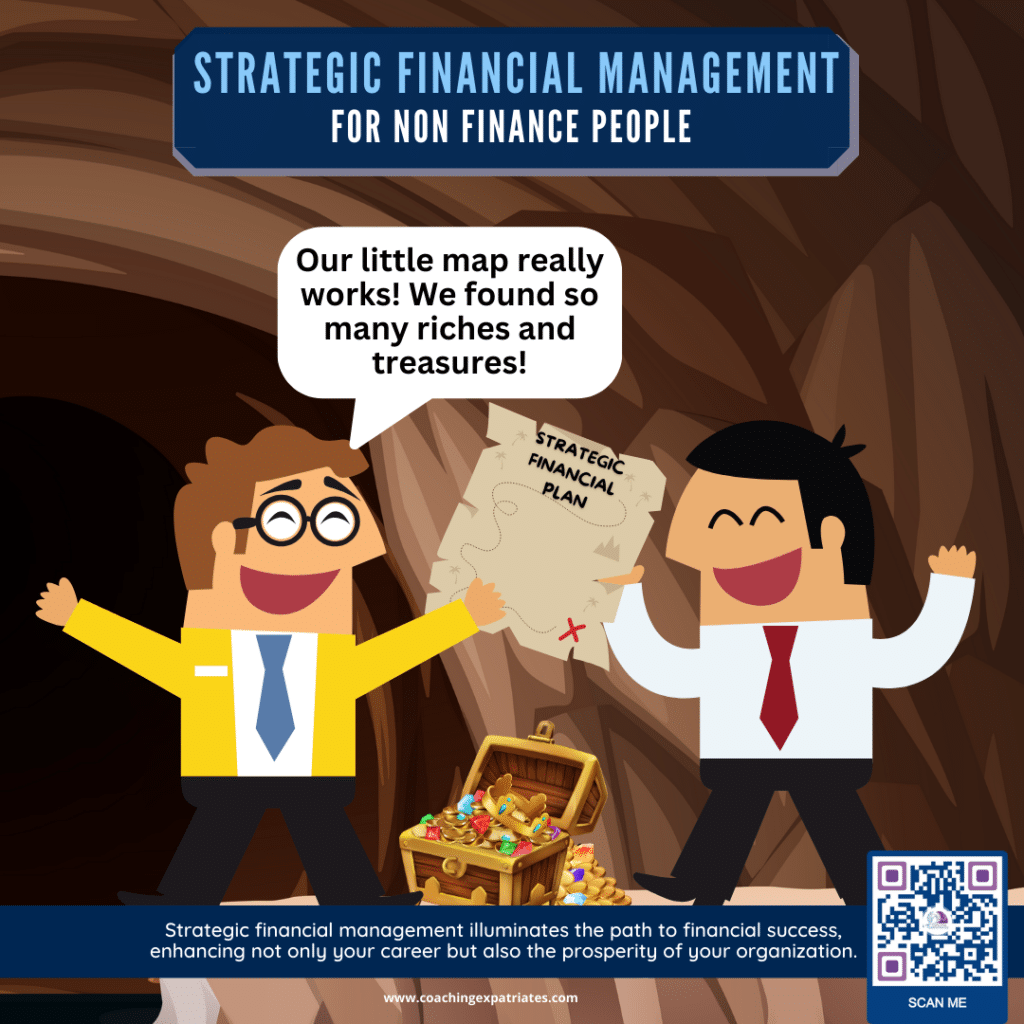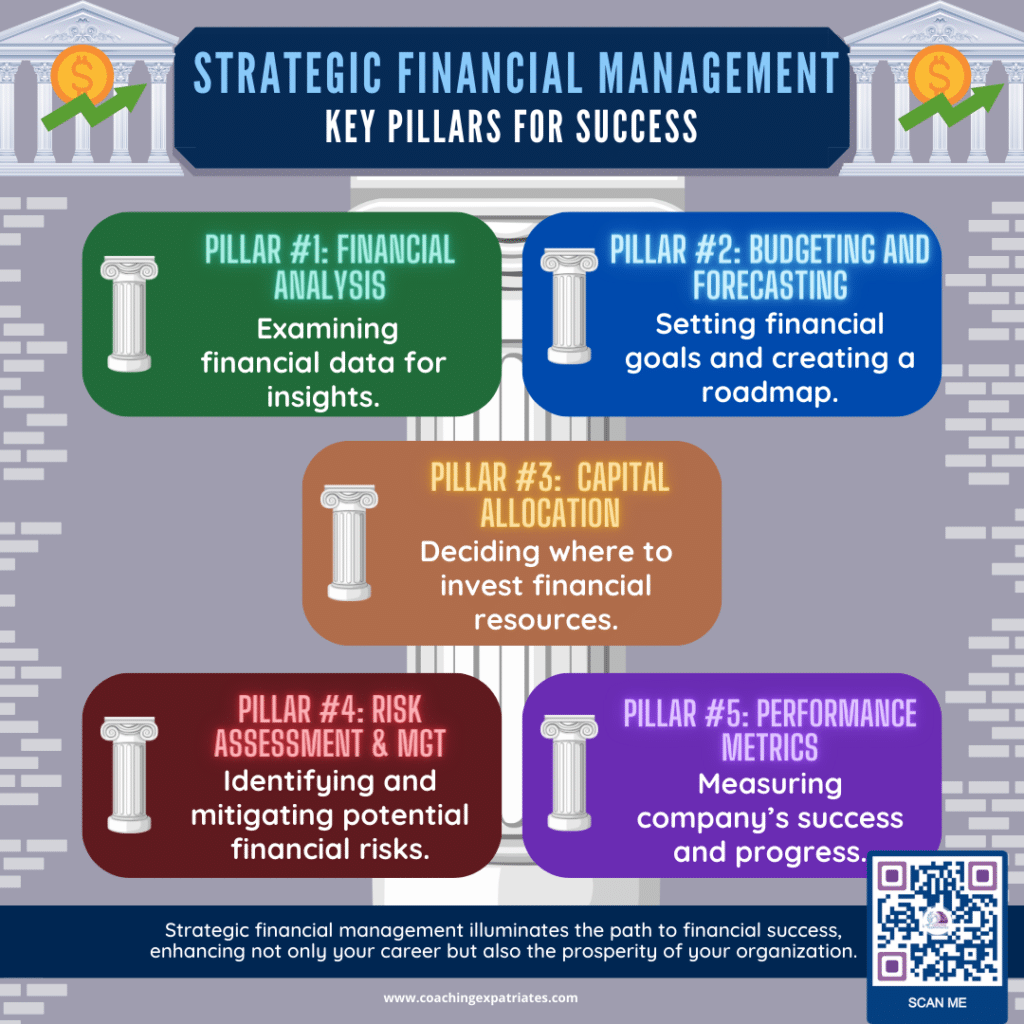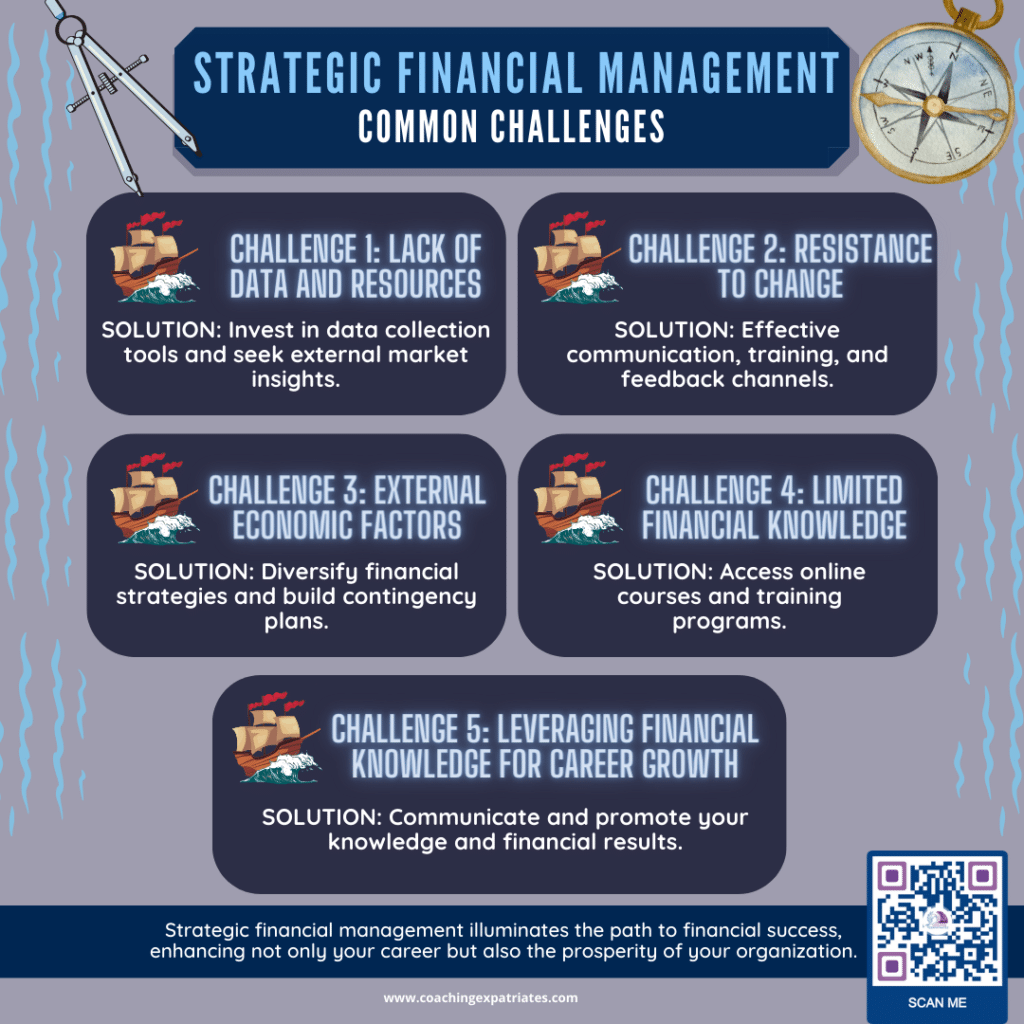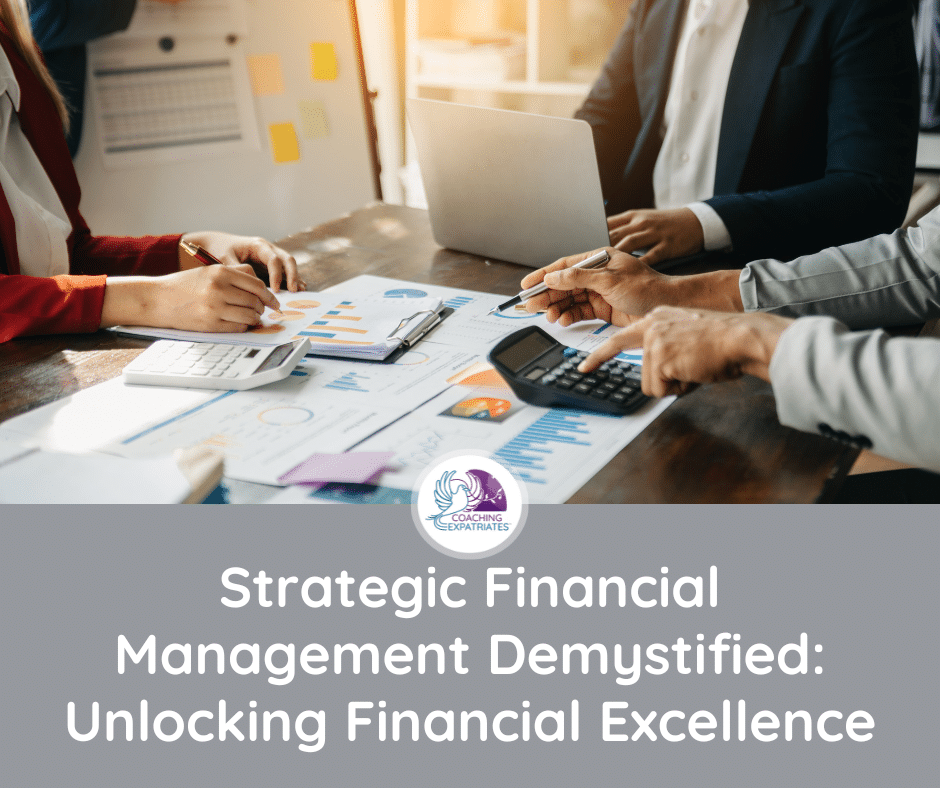In the ever-evolving landscape of business, the ability to make better decisions is a hallmark of a successful global leader. Whether you’re at the helm of a multinational corporation, a burgeoning startup, or anywhere in between, your choices can shape the destiny of your organization. In this complex, interconnected world, where market dynamics shift in the blink of an eye, one essential tool emerges as the compass guiding your journey to success: Strategic Financial Management.
When I was young, I used to immerse myself in adventurous games of treasure hunts. I’d invest countless hours meticulously crafting imaginary maps that led to hidden treasures, all within the confines of my vivid imagination. These imaginative pursuits often saw me embarking on epic quests, facing challenges, and encountering extraordinary situations and people. And in these thrilling make-believe journeys, I would always go back to my map as my guide to come up with new fantastic stories for my play.
Strategic financial management bears a striking resemblance to those childhood treasure hunts. It, too, provides a map, but this one is not a creation of imagination; it’s a blueprint for financial success. Your reward at the end of this real-world treasure hunt is indeed your treasure, in the form of financial stability, growth, and prosperity. Strategic financial management is a highly important activity that resides at the core of Organizational Leadership, one of the four success pillars of The Global Leadership Pillars™. It shapes the destiny of organizations while leading ideas. Ideas that are vetted or chosen by your financial acumen.

But what makes strategic financial management so crucial? Why is it the cornerstone that bridges the gap between our aspirations and tangible results?
The answer is simple yet profound: Strategic financial management empowers us to make better business decisions.
In this blog post, by sharing words and ideas that can resonate with and illuminate any professional, not only people working in finance, I want to make the intricate world of strategic financial management more accessible and relatable to a broader audience. My aim is to demystify complex financial concepts and present them in a way that empowers professionals from all walks of life to harness the power of financial wisdom for their respective journeys to success in their businesses.
Benefits Of Strategic Financial Management
Now that we’ve established the pivotal role of strategic financial management in the realm of organizational leadership, let’s roll up our sleeves and dive into the tangible benefits that await those who harness its power. Think of these benefits as the rewards of wielding a finely tuned instrument in the world of business orchestration. Here are the key advantages:
Improved Decision-Making
In the fast-paced arena of business, decisions often come at you like rapid-fire rounds. In such a landscape, the ability to make informed, data-driven decisions isn’t just a luxury; it’s a necessity. This is where strategic financial management shines as a guiding beacon. It equips you with a panoramic view of your organization’s financial landscape, illuminating the consequences of each choice before you. Armed with this knowledge, you can navigate complexities, seize opportunities, and sidestep pitfalls with confidence. Strategic financial management empowers you to make decisions that aren’t just educated guesses but strategic moves grounded in financial insight. It also provides the facts, data and narrative to influence other decision-makers on key ideas.
How this could play out: Imagine you’re the CEO of a tech startup. You have two potential growth opportunities on the table: expanding into a new market or launching a new product line. Without a robust financial management strategy, you might make a gut-based decision. However, by analyzing your financial data and conducting a cost-benefit analysis, you discover that the product expansion is not financially viable in the short term due to high production costs. Instead, you decide to enter the new market, which promises quicker returns and aligns with your financial goals. This data-driven decision-making enabled by strategic financial management leads to a more profitable outcome.
Risk Mitigation
Risk is an inherent element of business, but it doesn’t have to be a lurking threat. By adopting a strategic financial management approach, you become a risk warrior, equipped with the tools to identify, assess, and mitigate potential pitfalls. Whether it’s market volatility, economic downturns, or unexpected challenges, a robust financial strategy serves as your shield. It allows you to allocate resources wisely, build reserves, and implement risk management protocols. In essence, it transforms risk from an adversary into an opportunity for resilience and growth.
How this could play out: Consider a global manufacturing company facing supply chain disruptions due to a global disaster (any resemblance to COVID-19 time is a mere coincidence). Without strategic financial management, the company might struggle to adapt, incurring substantial losses from production delays and increased costs. However, with a proactive financial strategy in place, the company had built up a financial cushion. This allowed them to weather the storm, implement contingency plans swiftly, and minimize the financial impact of the disruption. The ability to assess and mitigate risks through strategic financial management proved invaluable.
Long-Term Sustainability
The journey to success isn’t a sprint; it’s a marathon. Strategic financial management isn’t just about immediate gains; it’s about setting your organization on a trajectory of long-term sustainability. It fosters fiscal discipline and ensures that your financial decisions today align with your organization’s aspirations tomorrow. By carefully planning, budgeting, and allocating resources, you build a strong foundation for lasting success. This sustainability isn’t just about surviving—it’s about thriving in a rapidly changing business landscape.
How this could play out: Picture a retail giant aiming for sustainable growth in a highly competitive market. By implementing strategic financial management practices, the company systematically allocates a portion of its profits to research and development, innovation, and employee training. Over the years, this investment in long-term sustainability pays off. The company introduces cutting-edge products, improves operational efficiency, and retains a highly skilled workforce. This strategic approach not only leads to sustained profitability but also positions the company as an industry leader in the long run. During the 2020-23 COVID period, many companies that didn’t pay too much attention to financial planning & sustainability went bankrupt. It’s hard to weather a storm without preparation.

Competitive Advantage
In the cutthroat world of business, standing out from the crowd is paramount. Strategic financial management isn’t a secret weapon; it’s an overt advantage that sets you apart. When you have a solid grasp of your financial position, you can make strategic moves that competitors might overlook. Whether it’s seizing growth opportunities, optimizing costs, or investing in innovation, your financial acumen becomes a formidable competitive edge. It’s the difference between reacting to market shifts and shaping them to your advantage.
How this could play out: Take a global telecommunications company facing increased competition. Through strategic financial management, they identify a cost optimization opportunity. By renegotiating contracts with suppliers and streamlining operations, they reduce operational costs by 20%. This cost advantage allows them to offer more competitive pricing to customers while maintaining profitability. As a result, they gain market share, attract new customers, and outperform competitors who didn’t adapt as swiftly. Their strategic financial management approach becomes a clear competitive advantage.
These real-world scenarios demonstrate how the benefits of strategic financial management translate into tangible advantages, such as informed decision-making, risk resilience, long-term sustainability, and a competitive edge in the marketplace. These benefits can significantly impact the success and longevity of organizations across various industries. And as you can see, these are things that don’t depend on the finance team alone. They can help do the math, but the strategy behind the plans come from all the different department and places inside the organization. After all, organizational leadership is exactly that: it leads ideas in the organization. And ideas come from all places and levels inside the company.
Key Components Of A Strategic Financial Management Plan
Alright, folks, it’s time to roll up our sleeves again and, this time, delve into the nuts and bolts of crafting a strategic financial management plan. Picture this section as the toolbox that holds the essential instruments for constructing your financial roadmap. These components are like the building blocks that create the framework of financial excellence. So, let’s grab our hard hats and dive in!
Financial Analysis: Unearthing Insights
First in our toolkit is financial analysis, the Sherlock Holmes of strategic financial management. Or, at least, that’s exactly how I felt back in the day in my corporate roles. It’s all about examining financial data with a magnifying glass to uncover valuable insights. Think of it as your detective work to understand the financial health of your organization. By scrutinizing income statements, balance sheets, and cash flow statements, you gain a clear view of where your money comes from, where it goes, and how it’s managed. This deep understanding becomes the cornerstone upon which you’ll make future financial decisions.
Imagine you’re a CFO in a multinational corporation. Through rigorous financial analysis, you unearth a recurring pattern of high operational costs in a specific division and location. Further investigation reveals that outdated equipment and inefficient processes are to blame. Armed with this insight, you initiate cost-saving measures and allocate resources to modernize operations. Over time, this strategic financial analysis not only boosts profitability but also positions your company as an industry leader in that location as well.
In 2010, I wanted to implement Oracle in my organization, which had an ERP from back in the late 70’s. That black screen with green content looked awful, but what was worse was the lack of insights it could provide me, plus, it didn’t “talk” with any other ERPs from around the world or to our Headquarters. Our outdated systems compromised timelines in finance closing, supply chain delivery, and even sales demand planning, to list a few. It was ridiculous. The implementation would cost millions of dollars and at least 2 years. Nobody wanted to invest in a region that was not growing. But that was the catch-22. That was one of the reasons why it was not growing. As the CFO, I had to go to top leadership to share financial data from all regions, compared to mine, and how this capital allocation would produce good results shall they approve it. All this data was gathered and created based on financial analysis, not from my numbers alone. What did the trick was showing how we would save money by investing money. We would have higher productivity, customer satisfaction, lower lead times, and better inventory turns with better demand planning. Yep, as my father used to say, “When you touch people’s pockets, you get their attention.“
So, the start of any good strategy is analyzing where the financial problems and opportunities are. And we can only do that if we sit our butts and do some financial analysis to unearth all the insights.
Budgeting & Forecasting: Plotting The Course
Next up, we have budgeting and forecasting — one of my favorite planning activities — they are the trusty navigational charts of your financial voyage. It’s here that you outline your financial goals and create a roadmap to achieve them. Budgets provide a detailed plan for allocating resources, while forecasts predict future financial performance based on current trends and historical data. Together, they act as your compass, guiding you towards your financial destinations.
Picture this: You’re the CEO of a retail chain. As the holiday season approaches, you rely on your budgeting and forecasting tools to plan inventory levels, staffing, and marketing campaigns. By accurately predicting customer demand and allocating resources accordingly, you not only meet sales targets but also avoid overstocking or understaffing (which are very common at this time of the year in retail chains). Your strategic financial foresight ensures a seamless holiday shopping experience, enhancing customer satisfaction and profitability without creating any havoc or unnecessary costs.
Capital Allocation: Where To Invest?
Now, let’s talk capital allocation—the art of deciding where to invest (or allocate) your financial and non-financial resources. It’s like playing a high-stakes game of chess, strategically positioning your assets for maximum impact. Whether it’s investing in new projects, acquisitions, or paying off debts, capital allocation is about optimizing your chessboard for success. You see, when I say financial resources, I don’t only mean the money you already have. I also mean the money you will borrow and the money you will be funded with (through multiple paths, like return on investments or new investors, for example) during the time of your project.
Imagine you’re the CFO of that tech startup from the previous example. You and the CEO faced two investment options: expanding the product line or entering a new market. Strategic capital allocation guides you to carefully consider the potential return on investment for each option. What this means is that you analyze the two scenarios and pretend you are going to make each happen. You then define how much money you need to put in each option to happen and identify how much money you’ll receive back in return. After rigorous analysis, you and the CEO decide to allocate resources to the new market entry option, which promises higher growth potential and aligns with your long-term strategy. This savvy allocation of capital sets the stage for sustainable growth and profitability.
Another point about capital allocation that I want to make clear is that capital allocation does not only mean money allocation. It also means your workforce allocation — or human capital — or structural capital like technology, energy, or even real estate. For example, you acquire a new land. Should you use it to build a new plant facility, a new megastore, or a research and development center? These types of financial decisions must be aligned with your goals and strategies. That’s why, in a strategic financial management plan, you define how you are going to allocate your financial and non-financial resources, considering your goals and your timing.
Risk Assessment & Management: Navigating Stormy Seas
In the unpredictable sea of business, risks are like hidden reefs waiting to capsize your ship. But fret not; risk assessment and management are your trusty navigational charts. They help you identify, evaluate, and mitigate potential risks before they become full-blown crises.
Risks can be internal, like the risk of having an employee sabotaging your product line, or external, like an unpredictable disease like COVID-19 breaking the supply chain around the world.
By proactively identifying and addressing risks, you steer your organization toward calmer waters and smoother sailing.
Consider the manufacturing company facing supply chain disruptions due to global events from one of our last examples. Through strategic risk assessment and management, they had already identified this vulnerability. They had contingency plans in place, alternative suppliers lined up, and a financial buffer to absorb unexpected costs. When the disruption hit, they weathered the storm with fairly minimal impact while competitors struggled to stay afloat. Their strategic risk management gave them a clear advantage in turbulent times.
Key Performance Metrics (KPI): The Scoreboard
Last but not least, in this blueprint, we have performance metrics—the scoreboard that tells you how well you’re playing the game. Have you ever thought that your favorite game’s scoreboard is actually a key performance metric or indicator (KPI)? These metrics track your progress, measure your successes, and highlight areas that need improvement. They are your yardstick for assessing the effectiveness of your financial strategies and ensuring alignment with your goals.
Imagine you’re the Head Medical Director of a healthcare organization. You’ve set a goal to reduce operational costs while increasing the quality of patient care. Performance metrics such as cost per patient, staff productivity, and patient satisfaction scores become your guiding lights. By regularly monitoring these metrics, you identify areas where efficiencies can be enhanced, resources reallocated, and patient outcomes improved. Your strategic use of performance metrics not only leads to cost savings but also enhances the overall quality of healthcare delivery. I recently watched an interesting series called “New Amsterdam” that portrays this example. Watch it with this financial perspective we are talking about, and I’m sure you’ll have some fun while also consolidating this theory.
A final note on KPI is that every sector and organization will have their core ones. In the example above, cost per patient is an important indicator for that organization, but obviously not for one that is producing nuts and bolts. However, the nuts and bolts organization might share the metric of staff productivity, for example. Each organization must define its guiding metrics or key performance indicators, be they financial or not.
In this toolkit of strategic financial management, financial analysis, budgeting and forecasting, capital allocation, risk assessment and management, and performance metrics serve as your trusty companions on your financial journey. They empower you to make informed decisions, steer clear of financial storms, and measure your progress toward achieving your organizational goals. If you think about it, that’s not much different from what Dave Ramsey preaches in terms of personal finances; it’s just using fancier words and corporate terms.

The 22 Financial KPIs You Should Know Of
Performance metrics in strategic financial management vary depending on the specific goals and objectives of the organization. However, many big global corporations commonly use a set of key performance indicators (KPIs) to assess their financial health and the effectiveness of their strategic financial management. Some of the most widely used performance metrics include:
- Return on Investment (ROI): ROI measures the profitability of investments and is a fundamental metric for assessing the financial success of various projects and initiatives.
- Return on Equity (ROE): ROE indicates how effectively a company is using its shareholders’ equity to generate profits.
- Earnings Before Interest and Taxes (EBIT): EBIT represents a company’s operating profit before considering interest and taxes, providing insight into its core operational profitability.
- Earnings Before Interest, Taxes, Depreciation, and Amortization (EBITDA): EBITDA further removes depreciation and amortization from EBIT to focus solely on operational earnings. This is mostly relevant in industries that rely on heavy machinery in their operations.
- Gross Margin: Gross margin reveals the percentage of revenue retained after subtracting the cost of goods sold (COGS), indicating a company’s profitability at the gross profit level.
- Net Profit Margin: Net profit margin measures the percentage of revenue retained as profit after all expenses, including taxes and interest. It’s also referred to as the bottom line.
- Operating Cash Flow: Operating cash flow assesses the cash generated from a company’s core operations, providing insight into its ability to meet short-term obligations.
- Free Cash Flow: Free cash flow represents the cash left over after all operating expenses and capital expenditures, showing the company’s ability to generate cash for growth or distribution to shareholders.
- Debt-to-Equity Ratio: This ratio helps evaluate a company’s financial leverage and risk by comparing its debt to its equity. Most industries have their own averages for this ratio, and when a business inside the industry has this ratio as an outlier, it raises red flags to investors.
- Current Ratio: The current ratio assesses a company’s short-term liquidity by comparing current assets to current liabilities, meaning the current stuff you have at your disposal versus the current stuff you have to pay.
- Quick Ratio (Acid-Test Ratio): The quick ratio is a more stringent liquidity measure, excluding inventory from current assets, to determine a company’s ability to cover short-term liabilities.
- Inventory Turnover: This metric evaluates how quickly a company sells its inventory and manages its working capital.
- Accounts Receivable Turnover: It measures how efficiently a company collects outstanding receivables.
- Days Sales Outstanding (DSO): DSO represents the average number of days it takes to collect payments from customers.
- Working Capital Ratio: This ratio assesses the company’s ability to meet its short-term obligations by comparing current assets to current liabilities. It’s the same as the current ratio.
- Market Capitalization: Market cap reflects the total value of a company’s outstanding shares and is often used in assessing its size and market position.
- Price-to-Earnings (P/E) Ratio: P/E ratio compares a company’s stock price to its earnings per share, offering insights into its valuation relative to its peers.
- Price-to-Sales (P/S) Ratio: P/S ratio relates a company’s stock price to its revenue, providing an alternative valuation metric.
- Dividend Yield: Dividend yield represents the annual dividend income relative to a company’s stock price, appealing to income-focused investors.
- Total Shareholder Return (TSR): TSR combines stock price appreciation and dividends to measure the overall return to shareholders.
- Profit per Headcount: Profit per headcount, also known as profit per employee, evaluates how effectively a company is utilizing its workforce to generate profits. It is calculated by dividing the company’s net profit by the total number of employees. This metric provides insights into the company’s productivity, efficiency, and the value it derives from its workforce. A high profit per headcount indicates efficient resource allocation and can be a key indicator of operational excellence.
- Stock Price Performance: Stock price performance measures how well a company’s stock has performed over a specific period, such as a year or quarter. It is an essential metric for assessing investor sentiment and market confidence in the company. Factors influencing stock price performance may include financial results, growth prospects, market conditions, and investor sentiment. Monitoring stock price performance can help assess the company’s market value and attractiveness to investors.
Key indicators such as Net Profit Margins, Free Cash Flow, Days Sales Outstanding (DSO), Working Capital Ratio, Profit per Headcount, and Stock Price Performance played pivotal roles in evaluating the strategic financial health of the organizations I worked for. Notably, Stock Price Performance carries substantial weight for many global organizations, especially in the context of publicly traded companies. Board Members of such large corporations frequently rely on this metric to gauge investor sentiment and gain insights into the company’s overall performance.
Many top leaders today map what are the most important financial KPIs in a sector and in a company in their first 90 days in a new position. Which is a pretty smart move. This helps them quickly improve their business acumen and be well prepared to display high executive presence when making good financial decisions by factoring in these KPIs in their decision criteria.
Crafting An Effective Strategic Financial Management Plan
Welcome to the heart of our journey, the topic we’ve been eagerly waiting for! In this section, we’ll delve into the nuts and bolts of crafting a plan that can steer your organization towards financial business success.
Strategic financial management is not just about balancing the books and keeping an eye on the bottom line, although that’s essential, too. It’s the art of aligning your financial resources with your overarching business goals. Imagine it as the North Star guiding your financial decisions, helping you navigate the complex terrain of the business world.
Now, let’s be honest – it’s not all about spreadsheets and fancy calculations (although those play a role). It’s about understanding where you are, where you want to go, and how you’ll get there financially. It’s about making strategic choices that position your organization for business growth, stability, and resilience.
If you read in between the lines that having a financial buddy or finance partner along the way is crucial, you got it right. No matter where you are in the organization and at which level, partnering with trustworthy finance folks will help you have a better experience while supporting your organization in strategic financial management. If you don’t work in a finance role in your organization, I assign you the homework of networking with a savvy financial person in your organization to become your trusted finance partner.
Setting the Course: The Foundation of Strategic Financial Management
At its core, crafting an effective strategic financial management plan involves setting a clear course for your organization. Here are the key steps:
Financial Audit: Taking Stock
Imagine you are buying a house. Gosh, houses are expensive! Would you want to invest tons of money and learn later that you have structural damage? Or that water infiltration puts an entire house column at risk? We do financial audits in a company for the same reason why we hire a House Inspector before a house purchase. We want to know what we are getting into and evaluate if we are up to it. So, think of a financial audit as a financial health check-up. Nobody likes it, but it’s necessary. Take a deep dive into your company’s financial statements, historical data, and performance metrics. What’s working, what’s not, and why? This step is all about understanding your current financial landscape and if there’s anything that needs immediate attention or fixing.
Setting Financial Goals: The North Star
Where do you see your organization in one year? Three years? Five years? Your financial goals should align with your overall business objectives. They should be specific, measurable, achievable, and relevant. Don’t forget the “time-bound” aspect – it’s your timeline for success. In many of the companies I worked for as a corporate executive and now as an executive coach working with corporate executives, what I see is that long-term planning is the North Star, but short-term planning becomes critical for achieving the financial KPIs. And it involves multifunctional and multicultural team members, as most matrix organizations take a more collaborative decision approach for strategic financial planning. Setting goals and making sure everyone is aligned and aiming for the same goal is critical.

Creating a Financial Strategy: The Roadmap
With your long-term goals in mind, develop a strategic financial plan. Start with thinking about the company’s long-term goals, then slowly break things down into shorter-term goals and timeframes. This involves making decisions about budget allocation, capital investment, risk management, and more. Your strategy should outline how you’ll allocate resources to achieve your long and short-term goals efficiently. Most likely, this will involve the top leadership of many regions and many sessions over a period of time. When I worked with GE, they had a robust budgeting cycle that was a mixture of financial planning and strategy planning. CEOs of each region of the globe were tasked to prepare the budgets for their regions with their respective CFOs and staff members, and present a business case with the strategy plan they had envisioned to achieve those financial commitments. The entire process every year lasted between 2 to 3 months, involving the regions and business units, and was highly demanding and stressful but well worth it.
Implementation and Monitoring: Turning Plans into Action
Most people think that knowledge and information are power. But knowledge and information become power when we take action on them. Crafting the plan is only half the battle, that can be made by pulling together all the knowledge and information you have. The real magic happens, though, when you put it into action.

Assign responsibilities, track progress, and regularly review your financial performance through your metrics. Be ready to adapt as circumstances change – flexibility is key. Due to more and more competition and market dynamism, most companies are changing these planning and budgeting cycles to shorter periods, like 90 days, on top of the full year’s plan.
Common Challenges And How To Overcome Them
As we sail through the waters of strategic financial management, it’s essential to recognize that, like any journey, there will be challenges along the way. In this section, we’ll shine a light on some of the common hurdles organizations face and, more importantly, how to steer your ship through these turbulent waters with finesse.
Lack Of Data And Resources: Navigating The Information Gap
Imagine you’re at the helm of a small startup. While you’re keen to implement strategic financial management, you find yourself navigating treacherous waters due to a lack of data and resources. It’s like setting sail without a map or compass.
So, what’s the solution?
Invest in data collection and analysis tools. In today’s digital age, data is a treasure trove of insights. Even on a tight budget, there are cost-effective software solutions that can help you gather and analyze financial data. Read some suggestions below. Additionally, consider partnering with industry associations or research firms for valuable market insights. Remember, while resources may be limited, the value of informed decision-making is priceless.
Resistance To Change: Smooth Sailing Through Rough Waters
Resistance to change is like an unexpected storm — you didn’t see it coming — but it can shake your vessel to its core. It often arises when employees or stakeholders are comfortable with the status quo and fear disruptions that strategic financial management might bring. New Bayer CEO Bill Anderson is introducing several strategic financial management changes, including streamlining of decision-making through management layer cuts. I am very curious how resistance will play into these organizational changes.
So, how can you weather these storms?
Effective communication is your anchor. Engage your team in discussions about the benefits of strategic financial management. Show them how it aligns with your organization’s long-term goals and can lead to long-term sustainability. Which means to say that a strong narrative and how it’s told is crucial for rallying people around the same new idea. Provide training, support, and professional executive coaching to ease the transition, and be receptive to feedback. In time, as your teams see the positive impacts on the organization, resistance is likely to subside. Also, people not willing to go through the changes will naturally leave, making room for individuals with a more positive attitude.
External Economic Factors: Navigating Economic Storms
External economic factors are like unpredictable weather patterns that can impact your financial voyage. Market fluctuations, economic recessions, or unforeseen global events can throw your well-laid business plans off course.
So, how do you navigate through these economic storms?
Diversify your financial strategies. This is the same as saying, “Don’t put all your eggs in one basket.” Just as a ship needs multiple sails to navigate various wind conditions, your organization should diversify its financial strategies to withstand economic turbulence. This might involve building financial reserves during prosperous times, having contingency plans in place, investing in different types of markets and products, and staying agile to adapt quickly to changing market dynamics. Another instrument many big companies use is hedging to create portfolio protection and reduce or mitigate certain risks.
Leveraging Financial Knowledge for Career Growth: The Secret
Many non-finance professionals possess valuable financial knowledge but struggle to showcase their expertise and the positive impact it has on their organization.
So, what can leaders do about it?
Don’t keep your financial expertise a secret. Actively communicate your financial insights and the results of your contributions to your team and superiors. Share success stories that highlight how your financial acumen has led to cost savings, revenue growth, or improved financial stability within your department or organization. Use performance reviews, presentations, and informal discussions to position your financial knowledge as an asset that contributes to your career growth. Proactively seek opportunities to collaborate with other teams, demonstrating how your financial insights can benefit various aspects of the organization. In doing so, you not only bolster your own career prospects but also contribute to a culture of financial literacy within your workplace.

In our journey of financial and strategic management, challenges are an inevitable part of the voyage. However, with the right tools, communication, and flexibility, you can navigate through these challenges and emerge stronger on the other side. You see, it’s not the absence of obstacles that define long-term success; it’s your ability to overcome them that truly matters.

Tools & Resources For Financial & Strategic Management
Embarking on the journey of strategic financial management requires more than just knowledge; it demands access to the right tools and resources. In this section, we’ll explore some essential assets that can aid you in your quest for financial excellence.
Financial Software and Tools: Your Swiss Army Knife for Finance
Imagine financial software and tools as your trusty Swiss Army knife—a versatile set of instruments that simplifies complex financial tasks. These tools are indispensable for crunching numbers, conducting analyses, and managing financial data efficiently.
For instance:
- Microsoft Excel: This spreadsheet software is a staple for financial and non-financial professionals. It can help you create models and simulations, perform data analysis, and visualize trends.
- Accounting Software: For example, QuickBooks, Xero, Wave App for smaller companies, or SAP and Oracle Accounting Suite for bigger ones. These tools streamline bookkeeping, invoicing, and financial reporting, saving you time and reducing the risk of errors.
How you can use them: Financial software and tools, including widely accessible platforms like Excel and accounting applications, offer a versatile toolkit that transcends the boundaries of finance. Non-finance professionals can harness these tools to streamline everyday tasks and enhance productivity. For instance, project managers can utilize Excel for strategic planning, project tracking, and budget management, creating interactive spreadsheets that visualize progress and spending. Small business owners can rely on accounting apps like QuickBooks or Xero to simplify invoicing, track expenses, and maintain financial records without the need for extensive accounting knowledge. By embracing these tools, non-finance professionals can efficiently manage the financial aspects of their work, improve decision-making, and ultimately contribute to the financial well-being of their projects or organizations.
Business Intelligence: Illuminating Financial Insights
When it comes to gaining deeper insights into your financial data, Business Intelligence (BI) tools are the shining stars. They help transform raw data into actionable information, enabling informed decision-making. These Business Intelligence tools empower professionals to uncover trends, patterns, and actionable information within their financial data, making them indispensable for financial management strategy.
For instance:
- PowerBI: Microsoft’s PowerBI is a robust BI tool that allows you to create interactive visualizations and reports. It’s particularly useful for financial analysts seeking to turn data into compelling insights and share them with their non-financial counterparts through dashboards.
- Business Objects (SAP BusinessObjects): SAP’s Business Objects is a suite of business intelligence tools that provides a comprehensive platform for data analysis, reporting, and visualization, catering to the needs of financial professionals. It also provides dashboards that can be scheduled to be sent to non-financial partners to keep them in the loop of financial outlook and information.
- Tableau: Tableau is renowned for its data visualization capabilities. Financial analysts can use it to create interactive and shareable dashboards that uncover valuable financial insights.
How you can use them: Non-finance professionals can harness the power of Business Intelligence (BI) tools to gain valuable financial insights, even if they don’t have an extensive background in finance. These user-friendly tools provide intuitive dashboards and visualizations that transform complex financial data into digestible formats. For example, marketing professionals can use BI tools to analyze the ROI of advertising campaigns, track customer behavior, and identify cost-effective strategies. Human resources teams can utilize BI to monitor labor costs and cost reduction, analyze employee turnover, and optimize compensation structures. By leveraging BI tools, non-finance professionals can make data-driven decisions, enhance operational efficiency, and contribute to the financial health and strategic goals of their organizations.
Online Courses & Training: Knowledge At Your Fingertips
In the age of digital learning, online courses are your passport to financial wisdom. They provide the flexibility to enhance your financial acumen at your own pace, anytime and anywhere.
For instance:
- Udemy: A leading online learning platform that offers a wide array of financial management courses. From “Financial Modeling” to “Strategic Financial Management,” Udemy’s courses cater to learners at various skill levels.
- Finance for Non-Finance Professionals Course Inside The Global Leadership Pillars™: An exclusive resource within The Global Leadership Pillars™ training. This course is tailored for non-finance professionals, breaking down complex financial concepts into digestible lessons and simulations.
How you can use them: Online courses and training in strategic financial management are invaluable resources for non-finance professionals looking to enhance their financial acumen. These courses provide accessible and structured learning paths, breaking down complex financial concepts into manageable modules. Professionals from diverse backgrounds, whether in marketing, operations, or human resources, can enroll in these courses to gain a solid understanding of financial principles. By doing so, they can learn how to interpret financial statements, budget effectively, and make data-driven decisions. These skills empower non-finance professionals to actively contribute to their organization’s strategic financial management, fostering cross-functional collaboration, trust-building, and a more comprehensive understanding of the financial impact of their decisions. You can strategically leverage your newfound expertise to enhance your career prospects. During performance reviews with your supervisor or boss, you can confidently demonstrate how your enhanced financial acumen has translated into better decision-making, cost-effective strategies, and a deeper understanding of the organization’s financial health. This proactive approach not only positions you as a valuable asset but also opens doors to career advancement opportunities, showcasing your dedication to personal and professional growth.
Professional Associations & Networks: Your Community Of Support
Just as sailors rely on a network of lighthouses to navigate safely, executive professionals benefit from belonging to professional associations and networks. These communities offer support, knowledge sharing, and networking opportunities.
For instance:
- Rotary International: Rotary is a global network of professionals and community leaders dedicated to humanitarian service and professional development. While its primary focus is on community service and leadership, many Rotary clubs offer financial literacy programs and seminars as part of their community outreach initiatives. Professionals from diverse backgrounds can join Rotary to not only contribute to their communities but also gain access to financial literacy resources and knowledge-sharing opportunities, making it a valuable community of support for enhancing financial literacy and leadership skills.
- LinkedIn Groups: Various LinkedIn groups and communities focus on financial management topics, offering a platform for discussions, knowledge exchange, and networking.
How you can use them: By participating in such associations or groups, individuals can expand their professional network, connect with mentors, and gain exposure to diverse perspectives. This not only enriches their understanding of the broader business landscape but also opens doors to potential collaborations and career advancement. Additionally, these associations frequently provide access to resources and educational materials that can help non-finance professionals develop a stronger grasp of financial concepts, enabling them to contribute more effectively to their organization’s financial health and strategic decision-making.
These tools and resources act as your compass, guiding you through the complexities of strategic financial management. Whether you’re honing your financial skills with online courses, leveraging software for data analysis, or connecting with fellow professionals in associations and networks, these assets are essential for charting a course toward financial success.
Now, if you’re eager to explore further and deepen your financial expertise, don’t forget to check out my exclusive financial course inside The Global Leadership Pillars™ training. It’s a valuable resource designed especially for non-finance professionals, offering a comprehensive understanding of strategic financial management.
Final Remarks
As we wrap up our exploration of strategic financial management, it’s clear that this discipline is not confined to the realm of finance teams alone. It’s a universal compass that guides professionals from all walks of life toward making informed decisions, fostering financial health, and ultimately propelling their organizations toward long-term success. Whether you’re a marketing guru, a project manager, or an HR specialist, the principles of strategic financial management are your allies in navigating the complexities of the modern business landscape.
So, as you embark on your journey armed with newfound knowledge, remember that the treasure map of strategic financial management is yours to follow. With each step, you illuminate the path to financial success, enhancing not only your career but also the prosperity of your organization. Let your commitment to lifelong learning and financial acumen be your guiding star, and may your financial endeavors yield a bountiful and prosperous future. Here’s to your continued growth, to making better business decisions, and to becoming successful global leaders in your own right.
If you are looking for a leadership development partner and consultant to help you improve strategic financial management and implement some of the ideas from this post, you can hire me as your executive and development coach. Have a Free Strategy Call with me. We will go over your specific needs, and devise together a methodical but fun way to turn your tables on this matter. We will implement practices and ideas together during our coaching journey so you can feel more confident and fulfilled.
If you are interested in developing specific global leadership skills, personally or team-wise, check out our online Global Executive Leadership program. We go over all The Global Leadership Pillars™ during 9 online modules, specially meant for global leadership development. It’s a unique leadership training methodology that will change the way you think, relate, and strategize as a global leader. You can also subscribe to our global leadership podcast, The Leadership Nest.
If you enjoyed this post, consider subscribing to our newsletter using the form below. We focus on providing good content to global leaders and executives who want to make impactful business decisions and be more inclusive and influential. We know your inbox is sacred, so we email just once per week, and we never sell, rent, or do anything funky with your information. Trust is the basis of Global Leadership, and we fully honor it.







